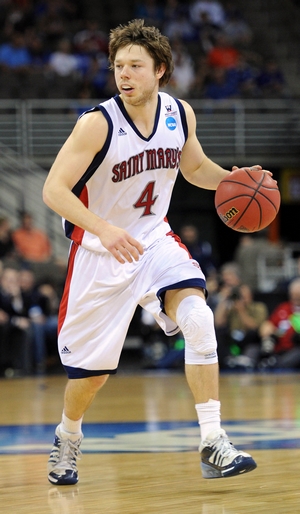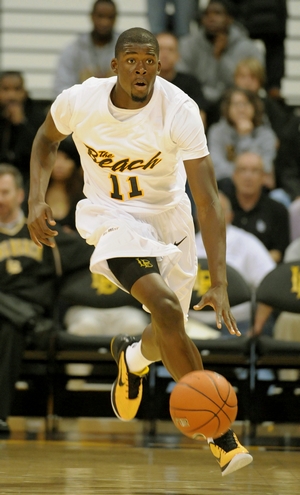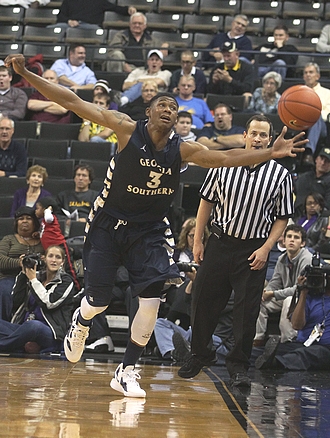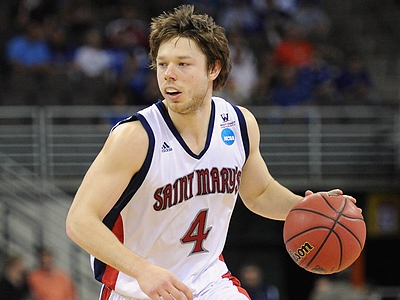Incoming freshmen have been excluded from these previews, as we'd like to wait and see what they have to offer on the NCAA level before we come to any long-term conclusions.
The Top 101 Prospects in the BCS Conferences
-Top 20 NBA Prospects in the Big Ten
-Top 20 NBA Prospects in the ACC
-Top 11 NBA Prospects in the Big XII
-Top 15 NBA Prospects in the Pac-12
-Top 20 NBA Prospects in the Big East
-Top 15 NBA Prospects in the SEC
-Top NBA Prospects in the Non-BCS Conferences, Part One
(#1) Tony Mitchell Video Scouting Report
-Top NBA Prospects in the Non-BCS Conferences, Part Two
(#2) C.J. McCollum
(#3) Jamaal Franklin
(#4) Adonis Thomas
(#5) Mike Moser
-Top NBA Prospects in the Non-BCS Conferences, Part Three
(#6) Doug McDermott Video Scouting Report
-Top NBA Prospects in the Non-BCS Conferences, Part Four
(#7) Ray McCallum
(#8) Alec Brown
(#9) Nate Wolters
(#10) Isaiah Canaan
-Top NBA Prospects in the Non-BCS Conferences, Part Five
(#11) Jackie Carmichael
(#12) Tarik Black
(#13) Robert Covington
(#14) Mike Muscala
(#15) Deonte Burton
-Top NBA Prospects in the Non-BCS Conferences, Part Six
(#16) Kendall Williams
(#17) Joe Jackson
(#18) Tony Snell
(#19) Elias Harris
(#20) Javon McCrea
#21, Matthew Dellavedova, 6-4, Senior, PG/SG, St. Mary's

Jonathan Givony
It's been three years since our last writeup of Matthew Dellavedova, and he's made some pretty substantial progress since. His scoring rate, 2-point percentage, free throw rate, assist rate and pure point rating have all improved in every college season he's played thus far, and he played a substantial role for the Australian national team in the Olympics in London this past summer.
Dellavedova returns for his final collegiate season trying to make one last impression on NBA scouts who have evaluated him extensively.
Listed at 6-4, Dellavedova has good size for a point guard, even if he does not possess great strength or a long wingspan. What he does possess is an extremely versatile skill-level and high basketball IQ, showing terrific creativity with the ball in his hands.
Dellavedova ranked as one of the most efficient players in college basketball last season when taking his passing and scoring into account, and has continued along the same lines in the early going this season thus far. He has been Saint Mary's primary ball-handler for a few years now even if he can also see some minutes off the ball, and is at his best in the pick and roll, where his tremendous timing and creativity really shine through.
Dellavedova is an extremely gifted and unselfish passer, being capable of getting the ball to teammates in virtually every way possible, be it with the bounce pass, lob, chest passes, post-entries and everything in between. Playing at his own unique pace, he does a terrific job of using his picks patiently and waiting to see how the defense reacts, before making the read and getting the ball to where it needs to be. He ranked in the top-10 amongst point guard prospects in assists per-40 and pure point rating last season, and is likely to do the game again this season.
Not just a distributor, Dellavedova is also capable of putting points up on the board as well, something his team needs him to do at times. He scored 15.5 points per game last season, shooting an efficient 53% from 2-point range and 35.5% from beyond the arc. He boasts a very quick and compact release on his jumper, being capable of making 3-pointers with deep range both off the dribble and with his feet set.
While Dellavedova has the quickness and ball-handling skills needed to create his own shot effectively from the perimeter at the college level, his athletic limitations show up a bit more when he's forced to drive into the paint and finish over the top of physically gifted defenders in traffic. He has a difficult time finishing over length in both half-court and transition situations, not possessing the strength or explosiveness needed to get all the way to the basket and still get off a high percentage shot. He's adapted somewhat by developing a very potent floater that he sometimes likes to shoot off one leg from 5-15 feet away, but there are question marks about how this will translate to the NBA level. In the Olympics for example, he struggled inside the arc.
Another question mark Dellavedova faces at the pro level revolves around his potential defensively. His lack of strength, length and lateral quickness makes it difficult for him to stay in front of opposing point guards, as he doesn't cover ground very well, and has a difficult time getting through screens. He counters this by putting a good effort in, and shows nice anticipation skills on this end of the floor, but his potential at this end of the floor is a bit murky against elite athletes.
While Dellavedova has his flaws, it's difficult these days to find creative point guards with size who can both distribute and score effectively. Dellavedova pick and roll prowess combined with his ability to make shots with his feet set and off the dribble are attractive traits. His quick and decisive style of play looks very well-suited to professional basketball, so he is bound to get some serious looks from NBA teams. If he's unable to latch on here, he will certainly have no shortage of offers to play at the highest levels of European basketball.
#22, James Ennis, 6'7, Small Forward, Long Beach State, Senior

Kyle Nelson
As a junior at Long Beach State, James Ennis was better known for his acrobatic dunks than for his basketball ability. After all, he cleared 6'11 in the high jump as a freshman at Oxnard College, even before he emerged as one of California's top junior college prospects. It seems as though the tide is starting to change. The junior college-transfer looks to be in the midst of a breakout senior season, however, complete with 17-point and 7-rebound and 18-point and 8 rebound performances against Arizona and North Carolina, respectively. The question now remains as to whether Ennis can replace Casper Ware's productivity while solidifying himself as a legitimate draft prospect.
Ennis is already an elite athlete with excellent quickness in the open floor and off his feet, capable of exploding quickly off of the floor, which makes him a human highlight reel in transition. In addition to his outstanding athleticism, he stands 6'7 with an incredibly long and wiry 210-pound frame, prototypical size for an NBA wing.
Ennis certainly looks the part, but his basketball ability has always lagged behind his athleticism. Last year he was a complementary player in Long Beach State's offense, with nearly 75% of his shots being created for him. He was able to convert an excellent 66% of his 2-point attempts, one of the best rates in the country, but struggled to get to the free throw line and relied too heavily on his streaky outside jumper.
Ennis was most effective scoring in transition as a junior, where he saw over 31% of his offensive possessions and where he utilized his elite quickness and athleticism to finish at an efficient 57.1% clip. He also thrived receiving the ball off of cuts and using his physical tools and shooting touch to get easy baskets. Almost all of his offense inside the arc came directly at the rim, as he lacks any type of mid-range game or ability to pull-up off the dribble for a jump-shot.
Ennis possesses physical and athletic advantages over almost anybody that guards him at the college level, but he lacks the ball handling ability to get to the basket and was not able to consistently draw contact when he did manage to get in the lane. He was not particularly turnover prone as a junior, but he has struggled mightily as a senior, getting to the line more often, but turning the ball over 4.3 times per game. So, while he clearly has a bigger offensive role as a senior, and looks more eager to attack opponents off the dribble, he is a long way away from being able to create his own shot consistently at this level, let alone at the next.
Where Ennis did show potential as a junior was as a long-range shooter, as he attempted 4.9 perimeter shots per 40 minutes pace adjusted and made 35% of his attempts. While his shooting motion starts a bit low and he does not get a lot of elevation on his shot, he has consistent mechanics and has shown the ability to make shots effectively from a standstill. He was a very good spot-up shooter from long range, making 43.8% of his unguarded attempts from distance. He has yet to find his groove as a shooter during his senior year, but he looks more comfortable as a shooter and quicker on the draw, which is a good sign when considering what he can offer at the next level.
There are significant question marks on the defensive end, however, as his below average awareness and inconsistent effort and focus belied his potential as a defender at the collegiate level. He did not always close out hard on shooters and he struggled to fight through screens as a junior, but his excellent length and solid lateral quickness allow him to be a formidable perimeter defender when he put his mind to it. His 2.1 steals per 40 minutes pace adjusted are a testament to how disruptive he can be, even with an inconsistent effort. Scouts will be watching to see if he can consistently work hard on the defensive end as a senior, as he certainly has the physical tools to be a better than average defender at the next level.
The question remains: can James Ennis develop into more than just an athlete on a consistent basis? He has embraced a larger role as a senior and has definitely showed more on the offensive end of the floor; but four games into the season, the answer is still unclear. He will likely never be more than a role player at the next level, but he must first prove to scouts that he can consistently hit spot-up three point shots while maintaining his focus and intensity on the defensive end. Fortunately, scouts will have plenty of opportunities to watch him in December match-ups against Syracuse, Ohio State, and UCLA, not to mention the Big West slate and the Portsmouth Invitational Tournament. Should James Ennis continue to play well against elite competition, then he could certainly see his draft stock rise in the coming months.
#23, Ronald Roberts Jr., 6'8, Power Forward, Saint Joseph's, Junior

Kyle Nelson
Few outside of Philadelphia knew much about Ronald Roberts before the start of his junior season, even though he was named the 2011-2012 Atlantic 10 Conference Sixth Man of the Year. That quickly changed when he scored 21 points along with 16 rebounds in an overtime upset against Notre Dame and followed it up with 15 points and 11 rebounds against Florida State. In just six months, Roberts went from being a key reserve in a stacked Saint Joseph's frontcourt to being its anchor, emerging as a prospect to watch in the Atlantic 10.
Though Roberts is undersized for the post at the next level he stands around 6'8 - he has a long and built 220-pound frame that looks as though it can carry more weight. Furthermore, he is an outstanding athlete, possessing excellent explosiveness and mobility, along with an aggressive style of play that allows him to maximize his physical gifts.
That being said, he is a work in progress on the offensive end. He was productive as a sophomore, to the tune of 17.1 points per 40 minutes pace adjusted, and is averaging 13.5 points in 35 minutes per game through four games. While he plays extremely hard, never giving up on a play and expending an immense amount of energy every time he steps on the floor, he is fairly raw in his skill-level, showing a rudimentary post-game and very little on the perimeter.
Roberts sees most of his offense right around the basket, but is much better suited as a finisher as opposed to as a creator. On film, he shows extremely raw footwork, preferring to either kick the ball out of the post or bully his way to the basket. He relishes contact inside the paint, drawing 6.1 free throws per 40 minutes pace adjusted as a sophomore and is currently attempting 9 as a junior, but struggles to create much offense on his own. Though he shows some basic post moves, particularly a running baby hook, he is extremely raw in the post and still largely lacks a go-to move even at this late stage.
Roberts is at his most effective cleaning up around the basket. He is an outstanding offensive rebounder, posting 4.6 offensive rebounds per 40 minutes pace adjusted as a freshman, 3.7 as a sophomore, and 6.9 in four games as a junior. His instincts and aggressiveness allow him to get his hands on missed shots and his explosiveness allows him to finish quickly and with authority. He also follows his shot and finds a lot of extra possessions by rebounding his misses. Roberts is also very good at scoring around the basket off of cuts, doing a great job of moving without the ball, running in transition, and communicating with his teammates.
Moving away from the basket, Roberts lacks serious polish. He attempted 14 jump shots as a sophomore and made 35.7% of his attempts, which included a variety of turnaround jump shots and a pair of makes form mid-range. His mechanics look solid, but on this small of a sample size, it's difficult to draw any definitive conclusions and his 60% free throw percentage this season is a career high, which is not an encouraging sign. Similarly, he put the ball on the floor a few times last season, facing his man up and taking him to the basket, but his extremely limited ball handling ability leaves much to be desired at this stage.
Roberts shows the same energy on the defensive end, where he compensates for his lack of ideal size by playing extremely tough, using his body, and moving his feet. He is a very good post defender at this level and, in addition to his length and athleticism, he demonstrates good fundamentals, as well. He has good lateral quickness for a player his size, which he puts to good use defending perimeter-oriented big men, closing out hard on shots, and while guarding the pick-and-roll. One area of concern, perhaps, is his defensive rebounding, where he has measured out below average in each of his three seasons, and where he posted just 5.9 defensive rebounds per 40 minutes pace adjusted.
The fact that Roberts has started the season strong against legitimate competition validates our impression that he is a prospect to watch moving forward. His relentless style of play, defensive potential, and athleticism suggest that he has what it takes to overcome his lack of ideal size at the next level. That being said, scouts will be watching to see if he can develop on the offensive end before he becomes a legitimate prospect. Roberts will have plenty of opportunities in future matchups against Creighton, Villanova, and a ramped up Atlantic 10 Conference schedule to prove to scouts that he can continue to hold his own against NBA caliber athletes on a nightly basis.
#24, Eric Ferguson, 6'8, Junior, SF/PF, Georgia Southern

Matt Williams
Earning the attention of a number of BCS programs while playing two seasons of prep school hoops at The Wichendon School (MA) in 2009 and 2010, Eric Ferguson opted to return to his hometown of Statesboro to play for Georgia Southern under his godfather, Head Coach Charlton Young. Following the path of his father, Calvester, who was Young's roommate and an all-conference center at Georgia Southern in the early 90's before starting a lengthy professional career in South America, Eric Ferguson paid immediate dividends for the program, earning All-Freshman Team honors and finishing as the team's second leading scorer.
Parlaying an All-Southern Conference first team selection as a sophomore into invitations to the Kevin Durant and LeBron James Skill Academies this past summer, Ferguson ranks among the most intriguing prospects in low-major basketball thanks in large part to his tremendous athleticism. A 6'8, 210-pound forward with a 7'0 wingspan and highlight reel leaping ability, Ferguson has improved his once skinny frame since arriving at Georgia Southern, and at this juncture, certainly looks the part of a NBA prospect.
Ferguson's skill level, aggressiveness, and instincts, however, remain a work in progress. Leading the Eagles in scoring at 15.4 points per-game last season, Ferguson's length and athleticism are his biggest assets offensively. He does most of his damage right at the rim as a finisher, where his 61% 2P% is indicative of his ability to play off the penetration of his teammates, run the floor in transition, and crash the offensive glass.
Functioning as an inside-outside threat, Ferguson sees touches in the post and in one-on-one situations away the rim as matchups warrant. His ability to out-jump defenders allows him to get his shot off at will in close at this level. He can put the ball on the floor and attack in a straight line and will toss in an occasional jump hook, but he doesn't have much in the way of perimeter shooting consistency, post-moves, or a refined handle, and proved extremely turnover prone last year.
Ferguson's progress out on the perimeter over the next two seasonsparticularly his jump-shot-- will play a key role in how he's viewed as a prospect down the road, as he has tremendous size for the small forward position, but would be considered undersized as a four. A solid rebounder, averaging an even 10 per-minute pace adjusted last season, Ferguson does not quite fit the mold of the undersized, but relentless hustle-four man at this point.
Possessing the athleticism to defend small forwards and face-up power forwards, Ferguson will need to play with more consistent energy to reach his full potential defensively. Typically matched up with opposing four-men, Ferguson has some impressive moments, including an occasional chase-down block, but appears apathetic at times. His length and explosiveness off the floor allow him to contest shots effectively, but he doesn't always get in a good stance when defending the ball away from the basket or fight for position on the block when defending the post. Considering his athletic merits and the stage he's at in his offensive development, Ferguson would benefit immensely from making the most of his physical tools defensively.
One of the best athletes in college basketball, there is plenty to like about Eric Ferguson. He's a highlight reel dunk or block waiting to happen, has impressive physical tools, and showed improvement from his freshman to sophomore season. Off to a slow start as a junior, Ferguson's ability to improve his skill level and take better advantage of his athleticism defensively will be worth keeping an eye on both this and next season.
#25, Zeke Marshall, 7-0, Center, Senior, Akron
Having had a similar season to the one we profiled in last year's preview, we've elected to wait and see what type of progress Marshall has made with a fresh perspective in a few months, rather than rehashing many of the same comments made last year based off last year's game footage.



































Comments